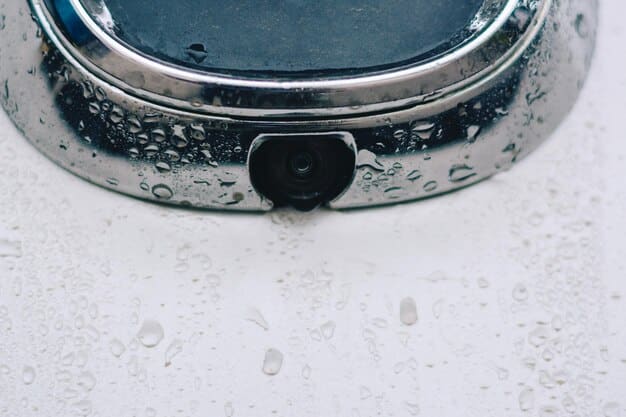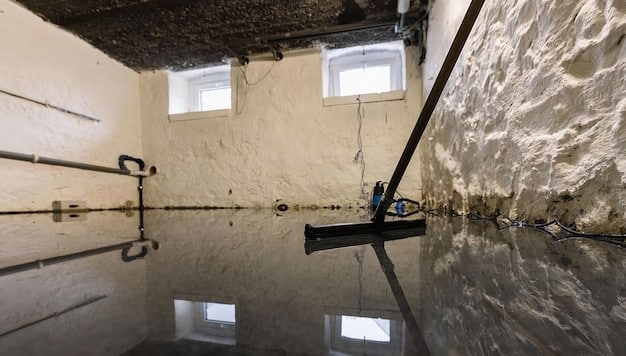Flood Alert: Smart Sensors to Prevent Water Damage

Flood alert systems utilizing smart sensors can significantly mitigate water damage in homes by providing early warnings, enabling prompt action and saving homeowners thousands in potential repair costs.
Water damage can strike unexpectedly, turning your safe haven into a stressful, costly nightmare. But what if you could get ahead of the game? Flood alert systems, powered by smart sensors, are changing the way we protect our homes, offering a proactive approach to prevent devastating water damage and save you thousands of dollars.
Understanding the Threat: The High Cost of Water Damage
Water damage is more than just an inconvenience; it’s a significant financial burden for homeowners. From burst pipes to overflowing appliances, the sources of water damage are varied and often unexpected. Recognizing the severity of this threat is the first step toward protecting your property and wallet.
Common Causes of Water Damage
Several factors can contribute to water damage in homes, ranging from obvious events like natural disasters to more subtle, everyday occurrences.
- Burst Pipes: Freezing temperatures can cause pipes to burst.
- Leaking Appliances: Washing machines, dishwashers, and water heaters are common culprits.
- Roof Leaks: Aging or damaged roofs can allow water to seep into your home.
- Sewer Backups: Blockages in sewer lines can cause wastewater to flow back into your home.
The impact of these events can range from minor cosmetic issues to major structural problems, making early detection and prevention crucial.
The Financial Toll of Water Damage
The financial consequences of water damage can be staggering. Repair costs can quickly escalate, depending on the extent of the damage and the materials affected. Additionally, water damage can lead to mold growth, which poses health risks and further increases remediation expenses.
Homeowners insurance may cover some water damage, but policies often have limitations and exclusions. Moreover, filing a claim can raise your premiums and potentially affect your future insurability. Investing in preventive measures, such as flood alert systems, can be a cost-effective way to avoid these financial pitfalls.
In conclusion, understanding both the common causes and the potential financial impacts of water damage underscores the importance of proactive measures. A flood alert system is a smart investment that can save homeowners significant money and stress in the long run.

How Smart Sensors Detect Water Leaks
Smart sensors are the cornerstone of modern flood alert systems, providing homeowners with real-time monitoring and early detection of water leaks. These devices use advanced technology to identify moisture and temperature changes, alerting you to potential problems before they escalate.
The Technology Behind Smart Sensors
Smart water sensors employ various techniques, including electrical conductivity and ultrasonic measurements, to detect the presence of water. When water is detected, the sensor sends an alert via Wi-Fi or Bluetooth to your smartphone or home automation system.
These sensors are typically small, battery-powered devices that can be easily placed in areas prone to leaks, such as under sinks, near appliances, and in basements. Some models also monitor humidity and temperature, providing a more comprehensive assessment of environmental conditions.
Placement Strategies for Optimal Protection
Strategic placement of smart sensors is critical to maximizing their effectiveness. Consider the following tips to ensure comprehensive coverage:
- Under Sinks: Place sensors under kitchen and bathroom sinks to detect leaks from faucets and drainpipes.
- Near Appliances: Position sensors near washing machines, dishwashers, and refrigerators to catch leaks from supply lines and drain hoses.
- Basement Floor: Place sensors on the basement floor, particularly near walls and windows, to detect leaks from seepage or cracks.
- Water Heaters: Put a sensor near the base of your water heater, as these appliances are prone to leaks as they age.
By strategically positioning your sensors, you can create a network of protection that provides early warnings and minimizes the risk of extensive water damage. The ability of smart sensors to detect minor leaks before they become major problems makes them an invaluable asset in safeguarding your home.
In summary, smart sensors offer a technologically advanced and highly effective solution for flood alert systems. By understanding their capabilities and placing them strategically throughout your home, you can significantly reduce the risk and impact of water damage.
Benefits of Installing a Smart Flood Alert System
The benefits of installing a smart flood alert system extend far beyond simple leak detection. These systems offer homeowners a range of advantages, from preventing costly repairs to providing peace of mind and enhancing home security.
Preventing Costly Water Damage Repairs
The primary benefit of a smart flood alert system is its ability to prevent extensive water damage and costly repairs. By detecting leaks early, these systems allow you to take swift action to address the problem before it escalates.
For instance, if a sensor detects a small leak under your kitchen sink, you can immediately shut off the water supply and fix the issue, preventing the leak from growing into a major flood that damages cabinets, flooring, and drywall. The cost savings from avoiding such damage can be significant, often far exceeding the initial investment in the flood alert system.
Peace of Mind and Home Security
Beyond financial savings, smart flood alert systems offer homeowners invaluable peace of mind. Knowing that your home is continuously monitored for leaks and that you will receive immediate alerts of any potential problems can reduce stress and anxiety.
Additionally, some smart flood alert systems integrate with home security systems, providing an extra layer of protection. You can often remotely monitor your home for leaks and receive alerts even when you are away, ensuring that your property remains safe and secure.
In conclusion, the benefits of installing a smart flood alert system are multifaceted. From preventing costly repairs and reducing water waste to providing peace of mind and enhancing home security, these systems offer homeowners a comprehensive and cost-effective way to protect their properties. Investing in a smart flood alert system is a proactive step toward safeguarding your home and ensuring its long-term value.

Choosing the Right Smart Sensor for Your Needs
Selecting the right smart sensor for your home requires careful consideration of your specific needs and preferences. With a wide variety of options available on the market, understanding the key features and factors can help you make an informed decision.
Factors to Consider When Selecting a Smart Sensor
Before purchasing a smart sensor, consider the following factors to ensure it meets your requirements:
- Detection Method: Determine whether you prefer sensors that detect water through electrical conductivity, ultrasonic measurements, or other methods.
- Connectivity: Choose sensors that offer reliable connectivity via Wi-Fi, Bluetooth, or other wireless protocols.
- Alert System: Look for sensors that provide timely and informative alerts through your smartphone, email, or other communication channels.
- Battery Life: Opt for sensors with long battery life to minimize maintenance and ensure continuous monitoring.
By carefully evaluating these factors, you can narrow down your options and select a smart sensor that aligns with your specific requirements.
Reviewing Popular Smart Sensor Models
Several popular smart sensor models are available, each offering unique features and capabilities. Researching and comparing different models can help you identify the best fit for your needs.
When evaluating smart flood alert products, consider features like remote shutoff capabilities, integration with home automation systems, and the ability to monitor multiple zones in your home. Some advanced systems even offer detailed water usage reports, helping you identify potential leaks and conserve water.
Ultimately, choosing the right smart sensor involves balancing your specific needs with the available features and budget. By conducting thorough research and reading customer reviews, you can make a well-informed decision and invest in a system that provides reliable and effective water leak detection.
In summary, selecting the right smart sensor requires careful consideration of your specific needs and the available features on the market. By evaluating factors such as detection method, connectivity, alert system, and battery life, and by researching popular models, you can choose a system that provides reliable and effective protection against water damage.
Installation and Maintenance Tips for Smart Sensors
Proper installation and regular maintenance are essential to ensure the long-term performance and reliability of your smart sensors. Following a few simple tips can help you maximize the effectiveness of your flood alert system and avoid potential issues.
Best Practices for Installing Smart Sensors
When installing smart sensors, adhere to the following best practices:
- Read the Instructions: Carefully read the manufacturer’s instructions before installing the sensors.
- Test the Sensors: Test the sensors after installation to verify they are functioning correctly.
- Secure the Sensors: Secure the sensors in place to prevent them from being accidentally moved or damaged.
- Check Connectivity: Verify that the sensors are properly connected to your Wi-Fi network or other wireless system.
By following these guidelines, you can ensure that your smart sensors are correctly installed and ready to provide reliable leak detection.
Regular Maintenance for Optimal Performance
To maintain optimal performance, conduct regular maintenance on your smart sensors. This includes:
- Battery Replacement: Replace the batteries as needed, following the manufacturer’s recommendations.
- Cleaning: Clean the sensors periodically to remove dust, dirt, or other debris that may interfere with their functionality.
- Testing: Test the sensors regularly to verify they are still functioning correctly.
- Software Updates: Ensure that the sensors’ software is up to date to receive the latest features and bug fixes.
By performing regular maintenance, you can extend the lifespan of your smart sensors and ensure they continue to provide accurate and timely leak detection.
In conclusion, proper installation and regular maintenance are crucial for the long-term performance of your smart sensors. By following best practices for installation and conducting routine maintenance, you can maximize the effectiveness of your flood alert system and protect your home against water damage.
The Future of Smart Home Water Protection
The future of smart home water protection is rapidly evolving, with ongoing advances in sensor technology, data analytics, and integration with other smart home systems. These developments promise to make water leak detection more accurate, efficient, and user-friendly.
Emerging Trends in Smart Sensor Technology
Several emerging trends are shaping the future of smart sensor technology, including:
- Enhanced Sensitivity: New sensors are being developed with increased sensitivity, enabling them to detect even the smallest leaks.
- Wireless Connectivity: Improved wireless connectivity options, such as longer-range Wi-Fi and low-power wide-area networks (LPWAN), are expanding the reach of smart sensors.
- Integration with AI: Artificial intelligence (AI) is being used to analyze sensor data and provide more accurate and personalized alerts.
These ongoing advancements are making smart sensors more reliable and effective in detecting and preventing water damage.
The Role of Data Analytics in Leak Detection
Data analytics plays a crucial role in enhancing the performance of smart flood alert systems. By analyzing patterns in water usage and sensor data, these systems can identify potential leaks more accurately and provide homeowners with valuable insights.
Additionally, data analytics can be used to predict and prevent future leaks. By identifying trends and patterns in water usage, smart systems can alert homeowners to potential problems before they occur.
The integration of data analytics into smart flood alert systems is transforming the way homeowners manage and protect their properties from water damage. As these technologies continue to evolve, they promise to provide even greater levels of protection and peace of mind.
In summary, the future of smart home water protection is bright, with ongoing advances in sensor technology, data analytics, and system integration. These innovations will make water leak detection more accurate, efficient, and user-friendly, helping homeowners to protect their properties and save money on costly repairs. Staying informed about these emerging trends and technologies can help you make the most of smart home water protection and ensure the long-term health and safety of your home.
| Key Point | Brief Description |
|---|---|
| 💧 Early Leak Detection | Smart sensors detect leaks early, preventing major water damage. |
| 💰 Cost Savings | Avoid expensive repairs and insurance claims with timely alerts. |
| 🔔 Immediate Alerts | Receive instant notifications on your smartphone when leaks are detected. |
| 🛡️ Enhanced Security | Integrate with home security systems for comprehensive protection. |
Frequently Asked Questions (FAQ)
▼
Smart water sensors are devices designed to detect the presence of water and alert homeowners to potential leaks. They use various technologies to identify moisture and temperature changes, providing early warnings to prevent water damage.
▼
Install smart water sensors in areas prone to leaks, such as under sinks, near appliances (washing machines, dishwashers, water heaters), and in basements. Strategic placement ensures comprehensive coverage and early detection of potential problems.
▼
Smart water sensors typically connect to your smartphone or home automation system via Wi-Fi or Bluetooth. When a leak is detected, the sensor sends an alert to your device, allowing you to take immediate action, no matter where you are.
▼
The benefits include preventing costly repairs, reducing water waste, providing peace of mind, and enhancing home security. Timely alerts allow you to address leaks quickly, avoiding extensive damage and potential health risks.
▼
Regular maintenance includes replacing batteries, cleaning sensors, testing their functionality, and updating the software. Following these steps ensures optimal performance and extends the lifespan of your smart water sensors, always keeping your home safe.
Conclusion
Investing in a smart flood alert system is a proactive and sensible decision for any homeowner looking to protect their property and finances. With the ability to detect leaks early and provide immediate alerts, these systems can prevent costly water damage, offer peace of mind, and enhance overall home security, ensuring a safer and more secure living environment.





